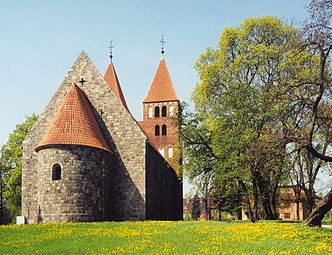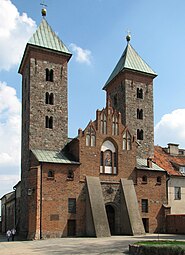| This article needs additional citations for verification. Please help improve this article by adding citations to reliable sources. Unsourced material may be challenged and removed. Find sources: "Romanesque architecture in Poland" – news · newspapers · books · scholar · JSTOR (June 2015) (Learn how and when to remove this message) |
 Collegiate church in Tum, one of the best preserved Romanesque structures in Poland, listed as a Historic Monument of Poland Collegiate church in Tum, one of the best preserved Romanesque structures in Poland, listed as a Historic Monument of Poland | |
| Location | Poland |
|---|---|
Romanesque architecture in Poland dates back to the 11th century to the reign of Casimir I the Restorer. It was developed in and ranging approximately from the 11th century until well into the half 13th century and it was succeeded by Polish Gothic architecture.
Romanesque style in Poland was preceded by Pre-Romanesque architecture of the early Polish state. Its prime foundations were the Wawel Cathedral in Kraków, the Gniezno Cathedral and the Poznań Cathedral (later re-built in different styles). Polish Romanesque architecture was influenced by the Polish Pre-Romanesque style. Most of Romanesque buildings in Poland can be found in Greater Poland, Kuyavia, Lower Silesia and Lesser Poland regions. Many Polish Romanesque buildings represent the characteristic Brick Romanesque style due to limited stone resources. Majority of these buildings are churches, rotundas and chapels. Most significant Polish Romanesque buildings include the Collegiate church in Tum, St. Nicholas Church in Wysocice, St. Peter and Paul-Collegiate in Kruszwica and the Saint Nicholas rotunda church in Cieszyn.
Historic Monuments of Poland
A number of Romanesque structures are listed as Historic Monuments of Poland, including:
- Abbey Church, Czerwińsk nad Wisłą
- Mogiła Abbey in Kraków
- Saint Procopius church as part of the Norbertine monastery complex in Strzelno
- Sulejów Abbey
- Tum Collegiate Church
- Romanesque-Gothic Saint George church in Ziębice
Gallery
-
St. Nicholas rotunda church, Cieszyn, Upper Silesia
-
 Chapter house at the Cistercian Abbey in Wąchock near Kielce
Chapter house at the Cistercian Abbey in Wąchock near Kielce
-
St. Nicholas Church, Wysocice, Lesser Poland
-
 Saint Procopius church, Strzelno, Kuyavia
Saint Procopius church, Strzelno, Kuyavia
-
 St. Peter and Paul-Collegiate, Kruszwica, Kuyavia
St. Peter and Paul-Collegiate, Kruszwica, Kuyavia
-
 Church of St. John of Jerusalem Outside the Walls, Poznań, Greater Poland
Church of St. John of Jerusalem Outside the Walls, Poznań, Greater Poland
-
 St Martin's Collegiate Church, Opatów, Lesser Poland
St Martin's Collegiate Church, Opatów, Lesser Poland
-
 Holy Name of Mary church, Inowrocław, Kuyavia
Holy Name of Mary church, Inowrocław, Kuyavia
-
St. Thomas of Canterbury church, Sulejów Abbey
-
 St. Giles' Church, Inowłódz
St. Giles' Church, Inowłódz
-
 Saints John and Catherine church, Świerzawa, Lower Silesia
Saints John and Catherine church, Świerzawa, Lower Silesia
-
 Church of St. John, Siewierz, Lesser Poland
Church of St. John, Siewierz, Lesser Poland
-
 St. Andrew's Church, Kraków, Lesser Poland
St. Andrew's Church, Kraków, Lesser Poland
-
 Saint Giles church, Wrocław, Lower Silesia
Saint Giles church, Wrocław, Lower Silesia
-
 Abbey Church, Czerwińsk
Abbey Church, Czerwińsk
References
- Wischermann, Heinfried (1997a). "The Romanesque Period in Scandinavia". In Toman, Rolf (ed.). Romanesque : architecture, sculpture, painting. Köln: Könemann. pp. 252–253. ISBN 3-89508-447-6.
- Rozporządzenie Prezydenta Rzeczypospolitej Polskiej z dnia 19 kwietnia 2021 r. w sprawie uznania za pomnik historii "Czerwińsk nad Wisłą - dawne opactwo Kanoników Regularnych", Dz. U., 2021, No. 767
- Rozporządzenie Prezydenta Rzeczypospolitej Polskiej z dnia 5 września 2023 r. w sprawie uznania za pomnik historii "Kraków - opactwo Cystersów w Mogile", Dz. U., 2023, No. 1867
- Rozporządzenie Prezydenta Rzeczypospolitej Polskiej z dnia 20 kwietnia 2018 r. w sprawie uznania za pomnik historii "Strzelno - zespół dawnego klasztoru Norbertanek", Dz. U., 2018, No. 981
- Rozporządzenie Prezydenta Rzeczypospolitej Polskiej z dnia 22 października 2012 r. w sprawie uznania za pomnik historii "Sulejów - zespół opactwa cystersów", Dz. U., 2012, No. 1242
- Rozporządzenie Prezydenta Rzeczypospolitej Polskiej z dnia 4 kwietnia 2022 r. w sprawie uznania za pomnik historii "Tum - zespół archikolegiaty pod wezwaniem Najświętszej Maryi Panny i św. Aleksego", Dz. U., 2022, No. 808
- Rozporządzenie Prezydenta Rzeczypospolitej Polskiej z dnia 19 lutego 2024 r. w sprawie uznania za pomnik historii "Ziębice - kościół parafialny pod wezwaniem św. Jerzego", Dz. U., 2024, No. 240
| Architecture of Poland | |
|---|---|
| Styles | |
| Buildings and structures | |
| Other | |
| Category | |